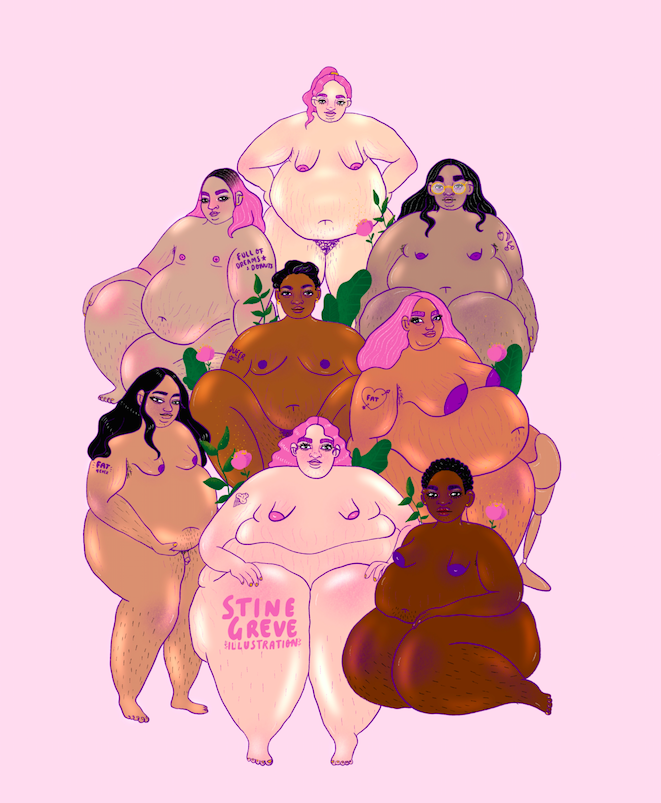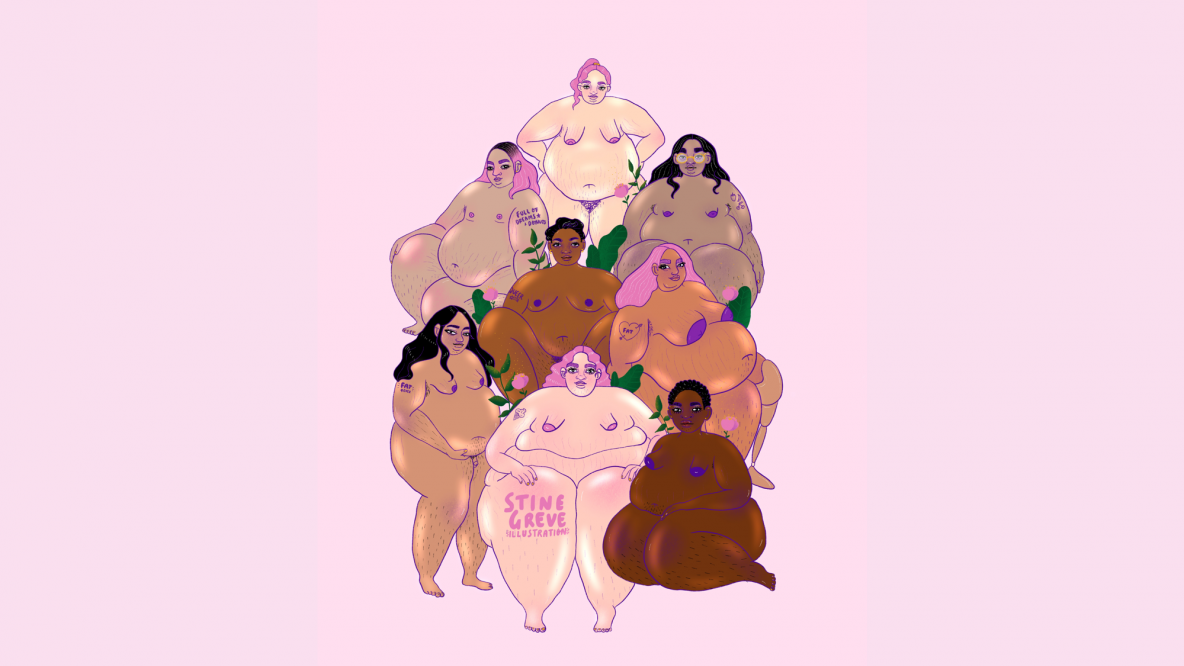Why The Body Positivity Movement Must Keep Moving
The Conservative government's recent attempt to encourage weight-loss has caused a high degree of controversy and consequently has reignited a focus on the body positivity movement in the UK.
By Harriet Clifford / 5 August 2020

Illustration by Stine Greve (@stinegreveillustration)
DISCLAIMER – Descriptors chosen in this article are used in line with what many activists use to describe themselves, but the author acknowledges that not everyone will have reclaimed these terms.
Some might argue that I should not be writing this article. As a white, slim, able-bodied, cisgender female, I am in the privileged position of moving through the world in a body which society deems acceptable. I can glide through life, seeing myself represented everywhere, knowing that I’ll always be able to find clothes that fit, or people whose experiences reflect my own.
That’s not to say that I don’t struggle to accept (let alone feel positive towards) my body. I have scars that I cover up to avoid questions and half a decade with an eating disorder means that I spend most days hiding away in baggy trousers and oversized T-shirts. But still, I am one of the privileged ones.
If I sit down and lean forward, I can give myself a couple of fat rolls, which, if I wanted to, I could photograph and post on Instagram with a positive caption about body acceptance. I would probably get lots of ‘likes’ and comments from friends and strangers, who would praise my boldness and gushingly label me as ‘brave’. That is, I am precisely the person who the body positivity movement in 2020 has evolved to empower, while also being precisely the person least in need of such a movement.
In the wake of Boris Johnson’s proposed campaign to encourage weight loss, the body positivity movement in its original form has taken a hit.
While many people are speaking out about how advocating a disordered relationship with food and calories is triggering for those with eating disorders, we also need to consider the impact that this will have on society’s already deeply ingrained fatphobia. Stigmatising people is not going to solve anything, and, as has already been said in various articles on the topic, people do not need to be told that they are fat.
Labelling any type of body as ‘wrong’ or ‘abnormal’ is specifically what the body positivity movement has always pushed against, calling for us to view our bodies as not only acceptable, but brilliant. Although it originated in the fat acceptance movement of the 1960s, the movement has been through many revolutions since then. Quickly gaining traction on social media from 2012 onwards, the third wave was largely fronted by fat, black and ethnic minority women advocating a progressive self-love and self-acceptance.
Since then, non-white plus-size models, influencers and artists have become easier to find on platforms such as Instagram, as well as occasionally in ad campaigns and magazines, while brands such as Boohoo, ASOS and Mango have extended their sizes ranges beyond a 16. Women like Lizzo, Enam Asiama, and Paloma Elsesser have created viral Instagram content or have been photographed for the cover of Vogue, while size 24 black model La’Shaunae Steward launch a range for Universal Standard.
But somewhere along the line, something has been lost in translation. Portia Brown, sex educator and ambassador for Kandid, an inclusive sex toy store, tells The Release, ‘If you Google “body positivity” or the hashtags associated with it, you likely won’t see many black or brown people represented. Once again, we have a movement that has been whitewashed and, on top of that, some of the more “popular” body positive influencers have a particular body type – curvy, hourglass figures, no belly, able-bodied – and are conventionally attractive.’ She adds, ‘There are still restrictions on who gets to love their bodies and participate in body positivity.’
These restrictions also apply to disabled bodies, something which educator and advocate Sinéad Burke has spoken and written about extensively, calling for representation of Little People within the fashion industry.
Disabled mum and fashion influencer Sophie Bradbury-Cox tells The Release, ‘I feel like I’m still not fully represented. In media, including television, advertising and in the fashion industry, disabled people are rarely seen. In the UK, more than one in five people are disabled – there is no excuse for our bodies to not be seen within the body positivity movement and to see ourselves reflected in mainstream media.’
Having studied Media/Technology and Diversity, Equity and Inclusion, Content Marketing Manager Myasia Burns tells The Release, ‘The gaps in the movement fall into advertising. Many times, what’s intended to be body positivity presents itself as tokenism or shock value. Another flaw is that when “real” representation is sought out, it is discarded after the campaign is complete. Ultimately, we need to fight for longevity.’
While we may not admit it, the fact that many of us are shocked when we see a fat or disabled body in mainstream media is precisely the reason why it is crucial that the body positivity movement does not stagnate.
We must not get complacent with how things are just because no one gets offended when a thin, white, able-bodied woman posts her fat rolls on Instagram.
Another, less discussed question raised by the women I spoke to is whether body positivity is in itself powerful enough to uproot our ingrained beliefs about bodies. Will accepting our bodies get rid of the prejudice and oppression experienced by people who are not white, thin, able-bodied and cisgender? Portia raises an important point when she asks, ‘How does this address fatphobia? How does this address ableism? We can’t “love” our way out of those things. We have to dig up the roots of that form of oppression and shake the dirt off.’
Shaking the dirt off will be messy and uncomfortable. I don’t know what it will look like and I’m in no position to speculate. All I do know is that we need to remove the shock-factor and question why we think a person is brave for showing off a fat or disabled body. Perhaps one day soon, no one will need courage to be themselves.
Art by
Words by
Share this article

